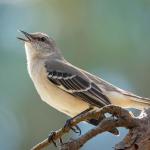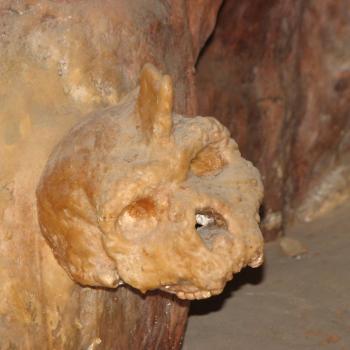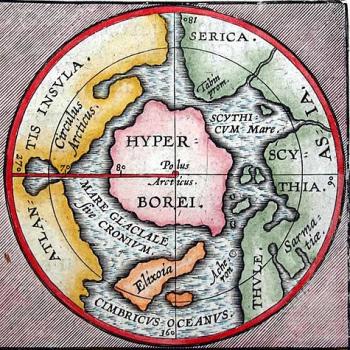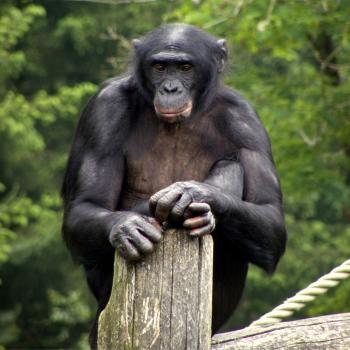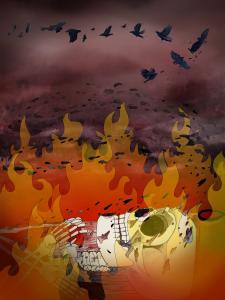
The three animals appearing most often in ancient human burials over the greatest span of time were red deer, snails and a variety of birds.
Archaeological and genetic evidence shows ancient European cultures once spent a great deal of time and labor transporting red deer and snail populations over great distances, and later burying their bones and shells with infants and children. Avian-related burial artifacts included engraved ostrich eggs, the wings of large waterfowl, mummified birds, and bird-related artwork ranging from murals, sculptures, and wooden effigies.
Long before the advent of modern science, both red deer and large birds displayed observable traits that seemed miraculous, specifically the ability to lose and then grow back parts of their bodies (antlers and wings). Other observable traits of red deer, snails, and birds also reflect the perpetual nature of the cycle of life.
Feathers, antlers & spirals
The annual process of molting is easily observable in large birds, which lose their flying feathers and then grow them back over about six weeks. An ancient cross-cultural myth tells of a swan maiden who loses the ability to fly when her feather cloak is stolen, but later regains it and flies away.
Growing up to 2.5 inches a day, red deer antlers can produce up to 16 points before falling off every year in March or April. As new antlers begin to grow, the red deer chews on the old antlers due to their high nutritional content, demonstrating visually that death can be the basis for new life.
A significant part of the Neolithic diet, snails were commonly observed. Similar to the red deer eating its antlers, newly hatched snails consume their own eggshells for the calcium. The snail’s ability to grow new spiraling rings on its colorful shell for 10 years or more was likely perceived as a simple but powerful message manifested by nature itself: The universe is inherently cyclical.
The sacredness of snails
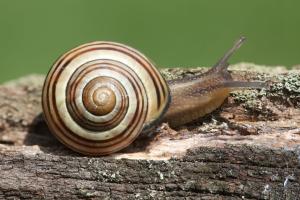
About 8,000 years ago in the French Pyrenees, Neolithic trekkers gathered up a large number of grove snails (Cepaea nemoralis), but instead of having a feast they kept the snails alive for the rest of their epic journey. The snails were translocated more than 700 miles by land and sea all the way to Ireland.
A 2013 genetic study on Cepaea nemoralis that painted this incredible picture didn’t address why the snails were transported, but a range of archaeological studies have found that snails were not only part of the human diet across Neolithic Europe but their spiral-shaped shells were buried with infants and children since the middle Paleolithic.
At Panga ya Saidi in southeastern Kenya, a three-year-old child was interred about 78,000 years ago with five shell fragments of the land snail Achatina next to its skull. Incredibly, the same burial practice was carried out 10,600 years ago at Shanidar Cave in northern Iraq, where spiral-shaped Achatina shells were buried with four infants, two children, and two adult men.
On Gozo Island off Malta in the Mediterranean Sea, a midden (mound) of red-banded snail shells was excavated near The Xagħra Stone Circle, a 6,000-year-old Neolithic funerary cave complex where a small clay sculpture known as the Snail with a Human Head was discovered. Its symbolic purpose is unknown.
When archaeologist Michael J. O’Kelly excavated the 5,200-year-old megalithic mound known as Bru na Boinne in County Meath, Ireland about 50 years ago, he found layers of turf and large, smooth “water-rolled” stones alternating with thin layers featuring thousands of snail shells from 19 different species, including Cepaea nemoralis.
Kelly acknowledged that most of the snail species in the mound were well outside their typical woodland habitat, but concluded the snails had gotten into the mound on their own. Kelly’s conclusion was supported by J.G. Evans of University College Cardiff, who suggested the snails fell down between gaps in the stones.
The conclusions of Kelly and Evans run counter to cross-cultural and genetic evidence showing that snail shells were long associated with burial practices, tombs, and temples in the Mediterranean and Near East, where the early farmers who built Bru na Boinne originated.
Genetic evidence shows that farmers from Anatolia (western Turkey by the Aegean Sea) migrated across North Africa and/or by island-hopping the Mediterranean, then through northern Spain, the Pyrenees, and up the west coast of France before arriving in Ireland about 6,000 years ago.
These early farmers left a trail of spiral symbols etched in stone along the way, including at 11,500-year-old Gobekli Tepe in eastern Turkey, the 5,600-year-old Ġgantija temple on Gozo Island, at tombs in Crete and Sardinia, and finally in great numbers across Ireland’s Boyne Valley, including the massive Entrance Stone at Bru na Boinne.
The counter-clockwise spiral

But why did the Neolithic trekkers in the Pyrenees choose the grove snail instead of the many other small land snail species they must have encountered on their epic journey? What made Cepaea nemoralis special enough to carry more than 700 miles over land and sea? The answer may be found in a biological quirk. Occasionally the shell of the grove snail spirals counter-clockwise instead of the right-hand turn typical of helical snails. To the Neolithic trekkers, the unusual counter-clockwise spiral was likely perceived as a message from the universe itself.
The stars turn around the sky counter-clockwise, the same direction of ancient circle dances and the same direction taken in walking meditation around sacred tombs, trees, or mountains (circumambulation).
The ample evidence uncovered in recent decades about how important the movement of stars was to Neolithic peoples provides important context for why Cepaea nemoralis was selected for translocation over other snail species.
Another unique attribute of the grove snail is the wide variety of patterns and colors within its fundamentally spiral shape, a range so unusual among snails that scientists continue to study it.
Snail as calendar in Mesoamerica
More than 7,000 years after Neolithic trekkers gathered grove snails in the Pyrenees, and halfway around the world, the snail shell embodied rebirth and the perpetual cycle of life for the Aztec, who painted intricate images on snail shells to build a cyclical calendar.
The Aztec feathered-serpent creator Quetzalcoatl had a snail shell on his chest and used a conch to blow the breath of life into the lifeless. Because the Aztec expected sacrificed children to be reincarnated, the children were ceremonially buried with thousands of snail shells at the massive Templo Mayor in the capital city of Tenochtitlan.
The symbolism of red deer

Some of the oldest burials of infants and children on record included the antlers and bones of red deer, beginning about 100,000 years ago in Israel, continuing through the Paleolithic era in Portugal and the Neolithic era in France, Ireland, and Scotland.
Perhaps the most visually compelling scene occurred about 5,800 years ago at the Carrowkeel passage tomb complex in County Galway, Ireland, where archaeologists believe a red deer skull with its antlers still attached was burned on a cremation pyre.
The trail of evidence begins at Qafzeh Cave in Israel, where the antlers of a red deer were buried on the chest of a 13-year-old Neanderthal about 100,000 years ago. The practice continued 60,000 years ago at Amud Cave on the Sea of Galilee, where the jawbone of a red deer was buried next to the pelvis of a Neanderthal infant.
About 24,500 years ago in the Lagar Velho rock-shelter near the northwest coast of Portugal, a four-year-old boy was buried with the right pelvis of a red deer by his head and the left pelvis of the same deer by his feet.
Forensic studies show that two or more people made tiny holes and decorative cutmarks on red deer teeth about 10,200 years ago at the Aven des Iboussie`res site in southeastern France, where scholars believe the teeth were used as ornaments during multiple burials.
Relocating red deer
Starting about 5,500 years ago, red deer were buried with the dead in 16 of 38 monumental tombs across the Orkney Islands of northern Scotland. When large tomb building was abandoned about 4,500 years ago, red deer were buried with the dead at nine of 15 settlement sites. A total lack of butchery evidence shows the red deer of Orkney were not eaten.
Archaeological and genetic studies have confirmed that red deer were transported by ancient cultures across the Mediterranean and western Europe to the Orkney Islands, where red deer on the island of Rum were found to have genetic roots in Sardinia. Red deer were also transported to the islands of Crete, Cyprus, and Ireland.
In addition to the annual regeneration of its magnificent antlers, it’s plausible that red deer were selected as sacred animals because of their reddish color, representing the vitality of blood. This may also explain the mound of red-banded snail shells found near the Neolithic funerary complex on Gozo Island in the Mediterranean. Red ocher was commonly used across ancient cultures to represent lifeblood and the soul in burial rituals, dating back to Neanderthals.
The divine qualities of birds
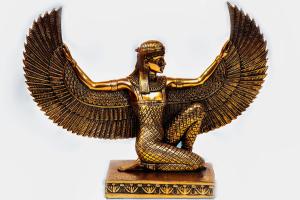
Across cultures and continents and thousands of years, a variety of bird species have been identified as guides for human souls through the afterlife.
In Denmark a 6,000-year-old grave held an infant covered with the wings of a swan. In ancient Estonia, a child was buried with a bird-bone whistle in its hands, two bird figurines, and the wings of a crane. In Siberia, the shaman was traditionally buried with the wooden effigy of a swan atop a pole, representing the flight of the shaman’s soul after death, while the Voguls carved bird images on coffins.
Birds and their eggs were a common symbolic artifact in ancient burials, a practice that evolved into a full-fledged industry in ancient Egypt, where more than 1.75 million mummified falcons and ibis were buried in egg-shaped jars just south of Cairo at Saqqara, with another million entombed at Tuna El-Gebel. Real ibis eggs were often scattered among the jars.
In ancient Egypt the sarcophagus was referred to as an “egg” in which the soul rejuvenates before being reborn. The goddess Isis was in the form of a raptor when she brought Osiris back to life by “originating coolness with her wings and wind with her feathers.”
Just 45 miles up the coast from Rome is the ancient Etruscan city of Tarquinia, founded about 2,800 years ago and known for its 6,000 graves and 200 tombs, which included ostrich eggs engraved by skilled artisans, eggs painted on vases and frescoes, and incised on bronze mirrors.
Birds of the Americas
At the Native American city of Cahokia in southern Illinois, human remains in Mound 72 were wrapped in beaded blankets patterned in the shape of a bird, with a bird-head near some of the human skulls.
Along the central coast of Peru, macaw feathers were once braided into human hair for burials, and mummified parrots were commonly buried. In southern Peru, the Moche buried vultures in tombs of the elite at Pacatnamu. A painted Moche pot depicts vultures leading a dead human figure to the underworld.
The burial of birds and bird artifacts with human remains was likely intended to infuse the soul of the deceased with the power of flight to a heavenly afterlife. A wooden bird looking straight up to the sky with wings outspread was attached to the top of a wood casket buried by the Haida on Queen Charlotte Island, Canada.
In the Roman classic Metamorphoses, Ovid described the ashes rising from King Memnon’s funeral pyre taking the form of a bird, “which flew on whirring wings, joined in noisy flight by countless sisters born from the same source.”
Time well spent
Scholars commonly consider how much time and labor was spent on a given cultural or religious practice to draw conclusions about its importance. How long a given practice persisted through time is also a major factor.
The widespread and long term use of red deer, snails, and birds in human burials, supported by the transportation of red deer and snails across vast distances, suggests the burial artifacts were of the highest importance.
Though it’s a matter of speculation, the physical and behavioral traits of red deer, snails, and birds suggest their bones, shells, and eggs were meant to infuse the dead with the universal power of rebirth inherent in the perpetual cycle of life.
(Ben H. Gagnon is the author of Church of Birds: An Eco-History of Myth and Religion, to be released in April 2023 by John Hunt Publishing, London; now available for pre-order.)

